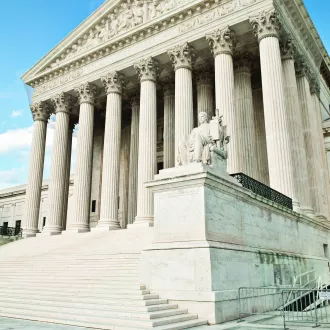Needed: More Civics and U.S. History Education
Students’ scores for U.S. history are the worst since 1994, and scores on civics declined for the first time, according to the National Assessment of Educational Progress (NAEP). Known as “The Nation’s Report Card,” the NAEP assesses history and civics proficiency for eighth-grade students in a nationally representative sampling given every four years.
In 2022, only 13 percent of students scored proficient in history and only 22 percent scored proficient in civics. Forty percent of students scored below the basic level of knowledge in U.S. history—compared with 34 percent in 2018.
While it is tempting to blame this decline entirely on learning disruptions caused by the COVID-19 pandemic, experts are quick to note that U.S. history scores fell by a similar amount between 2014 and 2018. The larger problem is more likely the diminished presence of history and civics—and social studies in general—in America’s classrooms for the last two decades.
A civics comeback in schools enjoys bipartisan support. A poll by Cygnal of more than 3,000 voters, conducted just before the 2022 midterm elections, showed that nearly 80 percent of respondents—Republicans and Democrats alike—believe that civics education is more important now than it was just 5 years ago, and 65 percent said they would support more funding for civics.
Teachers' Views on ChatGPT in the Classroom
OpenAI, an artificial intelligence (AI) research laboratory, launched ChatGPT in November 2022. Since then, the AI program has been the epicenter of heated debate, especially in education. While many teachers are enthusiastic about how the tool could transform their classrooms, others fear the program encourages a new form of cheating and plagiarism.
Because of the program’s simplicity, accessibility, and convenience, many students are using it to generate answers to homework questions and even write entire essays, claiming the chatbot’s writing as their own. Now many educators are adding a new task to their already overloaded plates: checking for AI plagiarism and revamping lesson plans to be “AI-proof.”
A recent survey, conducted by the online learning platform Study.com, underscored educators’ mixed feelings about the program. Forty-three percent of educators feel the program will make their jobs more difficult. The others, nearly 6 in 10, predict it will make their lives easier.
Quote byNEA President Becky Pringle, responding to the U.S. Supreme Court's ruling in June to end affirmative action in college admissions

A New Blueprint for Parent and Community Engagement

Despite efforts by politicians to divide parents and educators, these partners in the school community remain strong allies. That was the message and sentiment at a family and community engagement symposium held at NEA headquarters in March.
“We know policies in some states do not support our students and work against what we know must be a collaborative spirit,” said NEA President Becky Pringle at the meeting. “But we will not be separated from our parents and communities.”
The symposium marked the release of an educator-family partnership framework created by the National Association of Family Support and Community Engagement (NAFSCE).
According to the group’s research, 84 percent of educators would choose a school with more engaged parents over one offering a higher salary, but 73 percent identify engaging with parents and the community as challenging. Additionally, 61 percent say that state teaching standards don’t address building relationships and trust with families.
The vision offered in the NAFSCE framework is for the education system to honor and value the racial, cultural, and linguistic diversity of families and communities; to build trusting, reciprocal relationships; and to co-lead with families on equitable school systems.
The framework, Pringle said, “is one more tool to help us build the strong and fruitful relationships we must have between students, families, and educators.”
Learn more at nea.org/parent-community-engagement.
Who is Banning Books?
Although the growing number of book bans in libraries and schools is a disturbing and ominous trend, the banning activity is not spread evenly across the nation. Far from it. According to an analysis by PEN America, most book bans tend to be concentrated in a small number of school districts in politically conservative areas. During the 2022 – 2023 school year, book bans were most prevalent in districts in Texas, Florida, Missouri, Utah, and South Carolina. This handful of states, however, have established a model that could be duplicated in other parts of the country.

Students Speak Out About Barriers to Learning
The depression and anxiety that gripped so many students during the pandemic is showing few signs of fading away. That’s the main finding of a national YouthTruth survey of students in 845 schools across 20 states. For students in grades 6–12, depression, stress, and anxiety were the most frequently cited obstacles to learning. These problems were felt most acutely by high school students. Over 50 percent of high school students cited these mental health concerns as an obstacle. The survey report concludes that this distress is “ubiquitous in the culture of American teenagers.”
Supreme Court Student Debt Ruling Fails Educators
In a decision that undermines the future of countless Americans burdened by crushing student loan debt, the U.S. Supreme Court struck down the Biden administration’s Student Debt Relief Plan in the case of Biden v. Nebraska, on June 30.
“The court’s decision … reflects a failure to recognize the realities faced by student loan borrowers today,” said NEA President Becky Pringle, when the ruling was announced. “Student debt has reached astronomical levels, hindering the economic progress of individuals, families, and our nation as a whole.”
Student loan debt has ballooned to $1.7 trillion, and the burden falls disproportionately on communities of color and marginalized groups. The Supreme Court’s decision further exacerbates the existing inequalities in our education system.
The same day as the court’s decision, the Biden administration announced plans to create alternate pathways to provide debt relief for student loan borrowers. Learn more at bit.ly/BidenDebtRelief.
Many educators are still eligible for the Public Service Loan Forgiveness (PSLF) program. NEA has already assisted 40,000 members in the PSLF process and can help you, too.

